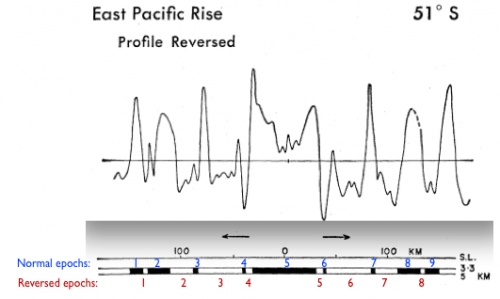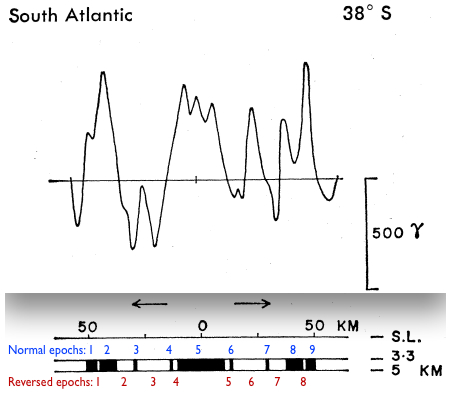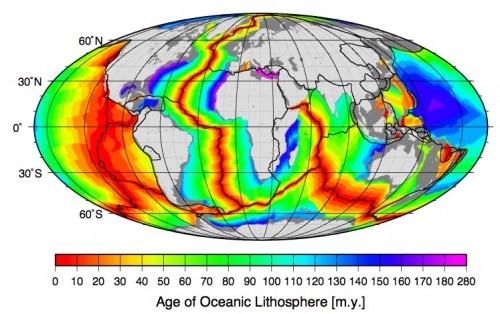Directions
Save the Lesson 3 Paleomag Problem Set to your computer. You will use this word processing document to record your work. The worksheet content is reproduced below but the link saves you from copying and pasting from the website. The worksheet is in Microsoft Word format. If you don't have access to Microsoft Word, let me know and I can give it to you in another format. You can use whatever text editor you like to work on this assignment. You can even do it by hand, as long as I can read your writing when you scan it. You will submit your worksheet to a Canvas assignment when you are done, so it must be in a format such as .doc, .docx, .pdf, .pages, .jpg, .png, .rtf or .txt so I can open it. If you have a format different than one of the ones listed, it still might work, but check with me first. If you do your calculations on a separate document or piece of paper, then submit those, too, so I can follow your calculations.
Problem Set
For the following problems let's assume that the magnetic poles coincide with the geographic poles to ease our calculations.
Example problem: State College, PA is located at 40.8° N, 77.9° W. Calculate its magnetic inclination.
Answer: Use the formula in which λ = the magnetic latitude and we are trying to solve for I. So,
Your turn!
Part 1
1.1 Auckland, New Zealand is located at 36.9° S, 174.8° E. Calculate its magnetic inclination.
1.2 Look up the coordinates of your hometown and calculate the magnetic inclination there.
1.3 If I = 0°, where are you?
Part 2
2.1 You are at a site in India whose coordinates are 23.3° N, 75.8° E studying some basalt outcrops and your magnetometer tells you that the magnetic inclination of the basalt is 30°. Calculate the latitude of this outcrop at the time the basalt erupted and cooled. (This problem is contrived on purpose to be the Deccan Traps, for those of you familiar with that location and where the Indian subcontinent was when they erupted)
2.2 If you can calculate the distance latitudinally that this site moved since this basalt erupted, do so. If not, say why you can't calculate it.
2.3 If you can calculate the distance longitudinally that this site moved since this basalt erupted, do so. If not, say why you can't calculate it.
2.4 Assume there was a 7% error in your magnetometer reading. How much would this error affect the distance you just calculated in 2.2 and/or 2.3?
The figure below is modified from Fred Vine's 1966 paper on seafloor magnetic reversals. Use it to answer the questions in part 3. Study the plot and verify in your head that you can find the names of seven epochs. These are geomagnetic epochs, which are not the same as "epochs" on the geologic time scale. I agree it is silly and confusing to use the same word for different things, but it's the way it is.

Part 3
3.1 Which geomagnetic epochs correspond to times when the field is normally polarized?
3.2 Which geomagnetic epochs correspond to times when the field is reversed?
Part 4
The East Pacific Rise profile below is also modified from Fred Vine's 1966 paper on sea-floor magnetic reversals. Use it together with the figure from Part 3 to answer the questions in Part 4.

4.1 Identify the 9 normal geomagnetic epochs and the 8 reversed epochs I have labeled with numbers. The blue numbers are meant to lie on top of the black bits that show normally polarized times, and the red numbers are meant to lie directly underneath the white bits that show reversed times. I want you to identify the epoch that corresponds with each number. It may be easier to identify repeating epochs if you start from the middle and work outward.
4.2 Which geomagnetic polarity epoch corresponds to the crust that is 100 km from the spreading ridge?
4.3 About how old is the crust that is 100 km from the spreading ridge?
4.4 Calculate the spreading rate for this ridge (assume it is constant over the time shown in the profile).
Part 5
The South Atlantic ridge profile below is also modified from Fred Vine's 1966 paper on sea-floor magnetic reversals. Use it together with the figure from Part 3 to answer the questions in Part 5.

5.1 Identify the 9 normal geomagnetic epochs and the 8 reversed epochs I have labeled with numbers. The blue numbers are meant to lie on top of the black bits that show normally polarized times and the red numbers are meant to lie directly underneath the white bits that show reversed times. I want you to identify the epoch that corresponds with each number. It may be easier to identify repeating epochs if you start from the middle and work outwards.
5.2 Which geomagnetic polarity epoch corresponds to the crust that is 50 km from the spreading ridge?
5.3 About how old is the crust that is 50 km from the spreading ridge?
5.4 Calculate the spreading rate for this ridge (assume it is constant over the time shown in the profile).
Part 6
The figure below is from Müller et al., 2007. Use it to answer the questions in Part 6. This figure shows the age of oceanic lithosphere around the globe ranging from warm colors (young) to cool colors (old).

6.1 How can you deduce the relative speeds of the spreading rates of the different mid-ocean ridges from this figure?
6.2 Compare the East Pacific rise with the South Atlantic ridge. Do the relative spreading rates agree with the calculations you made in Part 4, Question 4 and Part 5, Question 4?
6.3 Where is the oldest ocean crust?
6.4 Why isn't there any ocean crust on this map that is older than 280 million years?
Submitting your work
Save an electronic version of your problem set in a format I can read. I gave you a list at the top of the page, but check with me if you aren't sure. Name your file like this:
L3_paleomag_AccessAccountID_LastName.doc (or other format)
For example, former Cardinals pitcher and hall of famer Dizzy Dean would name his file "L3_paleomag_jhd17_dean.doc"
Upload your problem set to the Paleomag Problem Set assignment in Canvas by the due date indicated on the Overview page.
Grading criteria
I will use my general grading rubric for problem sets to grade this activity.